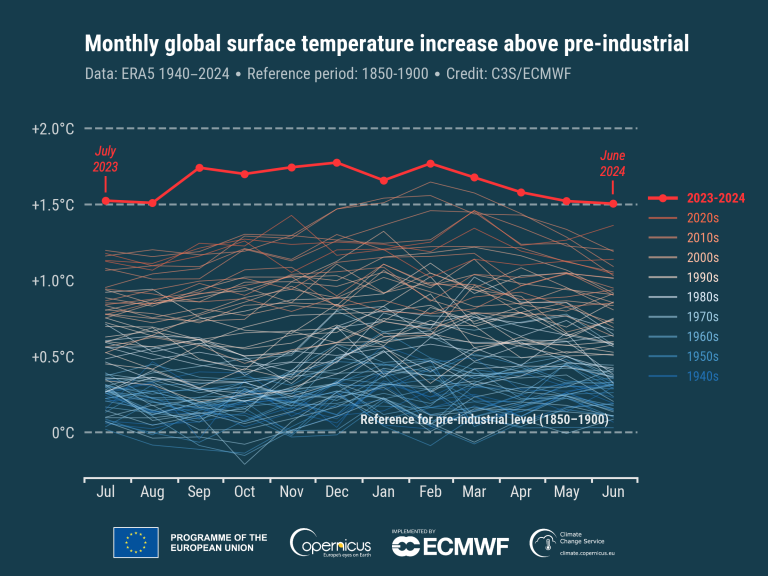
Photo: Erika Varga from Pixabay
The average global temperature last month was the highest ever recorded for June. It was the 12th consecutive month to reach or surpass 1.5 degrees Celsius above the pre-industrial average. It was also the 13th consecutive month in which the record average temperature for the given month was broken.
From July 2023 to June 2024, the global average temperature was the highest ever measured in a twelve-month period – 1.64 degrees Celsius above the pre-industrial average, which was the period from 1850 to 1900, according to data from the Copernicus Climate Change Service (C3S).
The average European temperature in June was 1.57 degrees above the 1991-2020 average, making it the second-warmest June on record.
Air temperatures were significantly above average in southern Italy, southeastern Europe, and Turkey, primarily due to heatwaves that affected Cyprus, Greece, and Turkey. Additionally, most of eastern and northern Europe experienced above-average temperatures.

As for the rest of the planet, temperatures were above average in eastern Canada, the western United States, Mexico, Brazil, northern Siberia, the Middle East, northern Africa, and western Antarctica.
“These latest figures from the Copernicus Climate Change Service unfortunately highlight that we will be exceeding the 1.5°C level on a temporary basis with increasing frequency, on a monthly basis. However, it is important to stress that temporary breaches do not mean that the 1.5°C goal is permanently lost, because this refers to long-term warming over at least two decades,” the World Meteorological Organization’s (WMO) Secretary-General Celeste Saulo.
Temperatures were around or below average in western Europe, Iceland, and northwestern Russia. This June was wetter than average over Iceland, central Europe, and much of southwestern Europe, due to heavy rainfall that caused flooding in some regions of Germany, Italy, France, and Switzerland.
Some parts of North America experienced above-average rainfall and a series of storms, including Hurricane Beryl. Precipitation was also above average in southwestern and southeastern Asia, southern Africa, and some regions of Australia and South America.
On the other hand, it was drier than average across North America, in several regions of Asia, and much of South America. Severe fires broke out in northeastern Russia and central South America.
Fifteenth consecutive month with record high sea temperatures
Ocean surface temperatures were below average in the eastern equatorial Pacific, indicating the development of the La Niña phenomenon. However, they remained at all-time highs in a significant part of the tropical western Pacific and west of Central America.
Overall, sea temperatures broke a record last month. The average reached 20.85 degrees Celsius. June was the fifteenth consecutive month with record-high sea temperatures.
“Even if this specific streak of extremes ends at some point, we are bound to see new records being broken as the climate continues to warm. This is inevitable, unless we stop adding greenhouse gases into the atmosphere and the oceans,” said Carlo Buontempo, Director of the Copernicus Climate Change Service.
The Arctic sea ice extent was 3% below average.
In Antarctica, it was 12% below average. Satellite data show that for June, the extent was smaller only last year, at 16% below average.


















Be the first one to comment on this article.